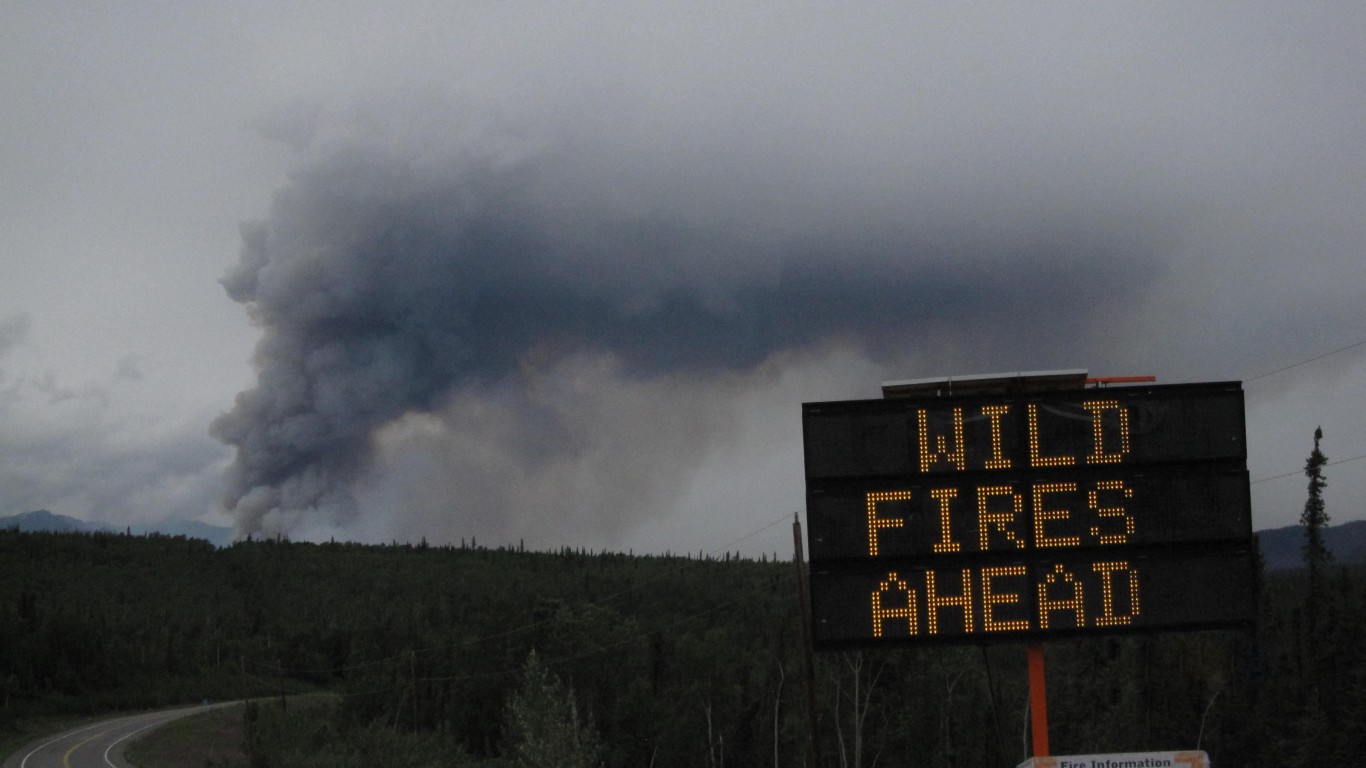
In 2020, 59,000 wildfires burned 10.1 million acres in the U.S., the second most recorded since 1960 and just barely lower than the total acreage burned in 2015. This year is projected to be another bad one. Already, 34,000 fires have burned 2.3 million acres across the country, with months of the 2021 North American fire season left.
As of July 22, there were 79 active wildfires in 13 states, all, with the exception of a small fire in Minnesota, in the western United States, according to the National Fire Information Center.
While it remains to be seen how 2021 will compare to last year’s historical season, this year has already produced at least one historical fire. The Bootleg Fire in Oregon has, as of the time of this writing, already burned nearly 400,000 acres, making it one of the largest of this century — and it has not yet been contained.
24/7 Wall St. has created a list of the most destructive wildfires in the U.S. this century. We reviewed data on wildfires that burned 100,000 acres or more since 2000 from the National Interagency Fire Center’s Fire (NIFC) and Aviation Management Web Applications Program to compile our list.
Because of extended drought, high temperatures, and dry grasslands, the western continental states and Alaska have fallen victim to most of the severe wildfires in the nation’s history. These fires have also been some of the nation’s worst natural disasters. Here is the worst natural disaster in every state.
Click here to see the 30 most destructive wildfires in the US this century
Click here to see our detailed methodology
30. Mustang Complex
> Area burned: 341,448 acres
> State affected: Idaho
> Year: 2012
> Cause: Lightning
A 2012 lightning strike ignited part of what came to be known as the Mustang Complex Fire. A complex is when two or more individual incidents in the same general area fall under the command of a single incident commander or unified command. The fire would go on to burn over 340,000 acres of land, primarily in Idaho but also in Montana. Hundreds of people were forced to leave their homes.
[in-text-ad]

29. Milford Flat
> Area burned: 363,052 acres
> State affected: Utah
> Year: 2007
> Cause: Lightning
The Milford Flat Fire, which scorched over 363,000 acres of southwestern Utah, is the largest and most destructive fire in the state’s history. It forced officials to shut down a large section of I-15, and the thick black smoke caused a number of traffic accidents, including one fatal hit and run.

28. LNU Lightning Complex
> Area burned: 363,220 acres
> State affected: California
> Year: 2020
> Cause: Lightning
A series of lightning bolt strikes struck the northern California region in late August 2020, causing wildfires to ignite in that area. The LNU Complex contained several fires. The two largest awere the Hennessey Fire in Napa and Lake counties and the Walbridge Fire in Sonoma County. The fire killed six people and injured five others. It also destroyed almost 1,500 structures and damaged over 200 more. and killed at least five people. The fire forced residents to evacuate parts of Yolo County, which is just west of the state capital of Sacramento, before it was contained in early October of that year.
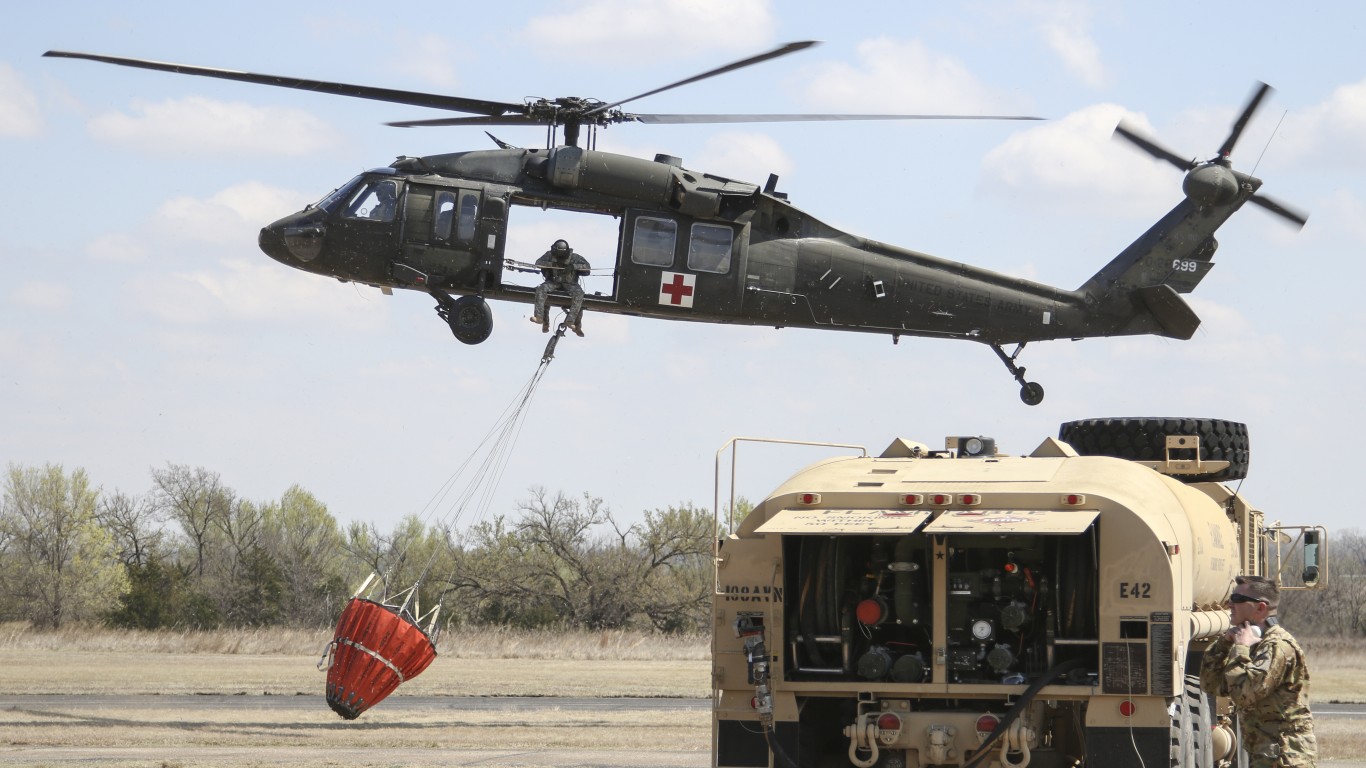
27. Anderson Creek
> Area burned: 367,740 acres
> State affected: Oklahoma
> Year: 2016
> Cause: Vehicle malfunction
Below normal rainfall in early spring led to the Anderson Creek fire. The blaze started in northern Oklahoma on March 22 and engulfed hundreds square miles of prairie and cattle grazing land, killing about 600 cattle. The fire extended into Kansas and became the largest grass fire in that state’s history.
[in-text-ad-2]
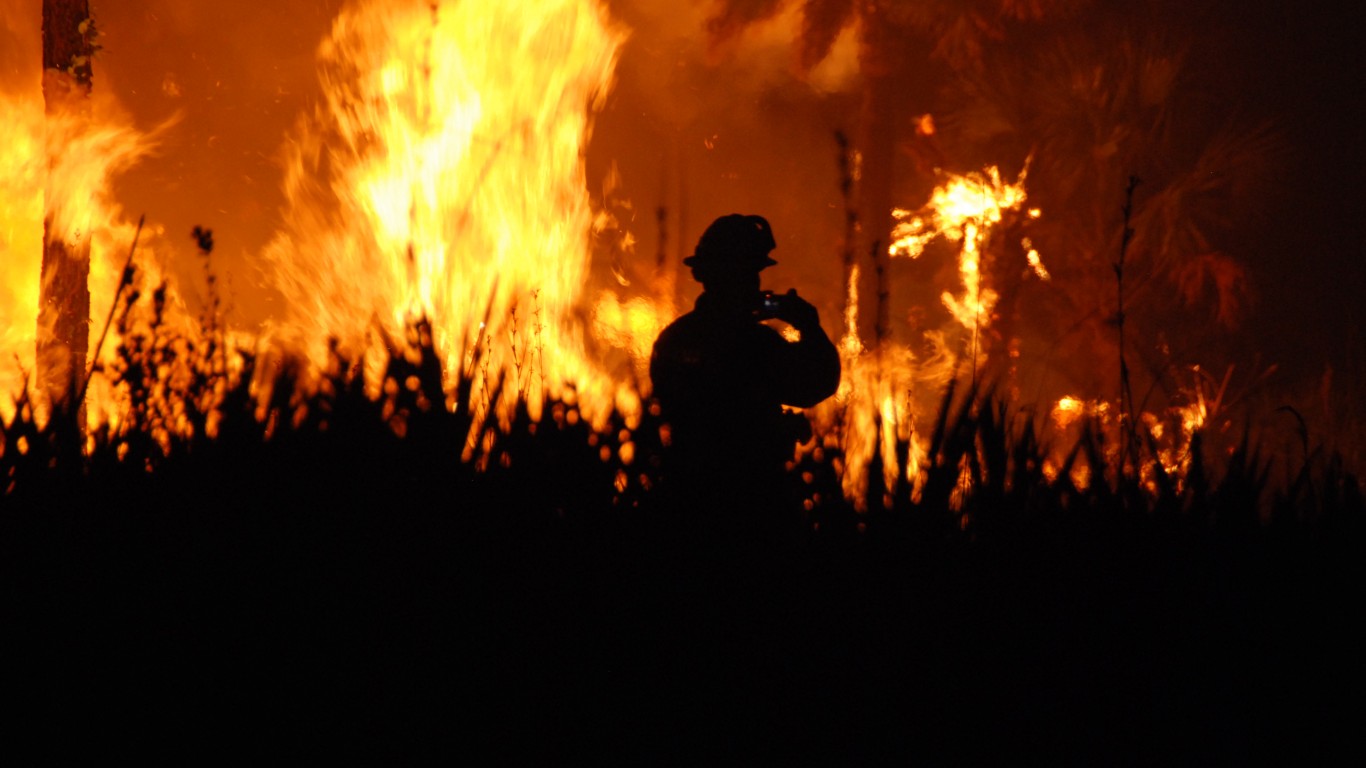
26. Creek
> Area burned: 379,895 acres
> State affected: California
> Year: 2020
> Cause: Undetermined
The Creek fire is one of several fires that burned hundreds of thousands of acres in late 2020. The fire was first identified on Sept. 4. It was not contained until Christmas Eve. During that time, it burned nearly 380,000 acres across Fresno and Madera counties. In addition to burning land and forests, the fire also created hazards in the area, causing trees and limbs to fall onto roadways.
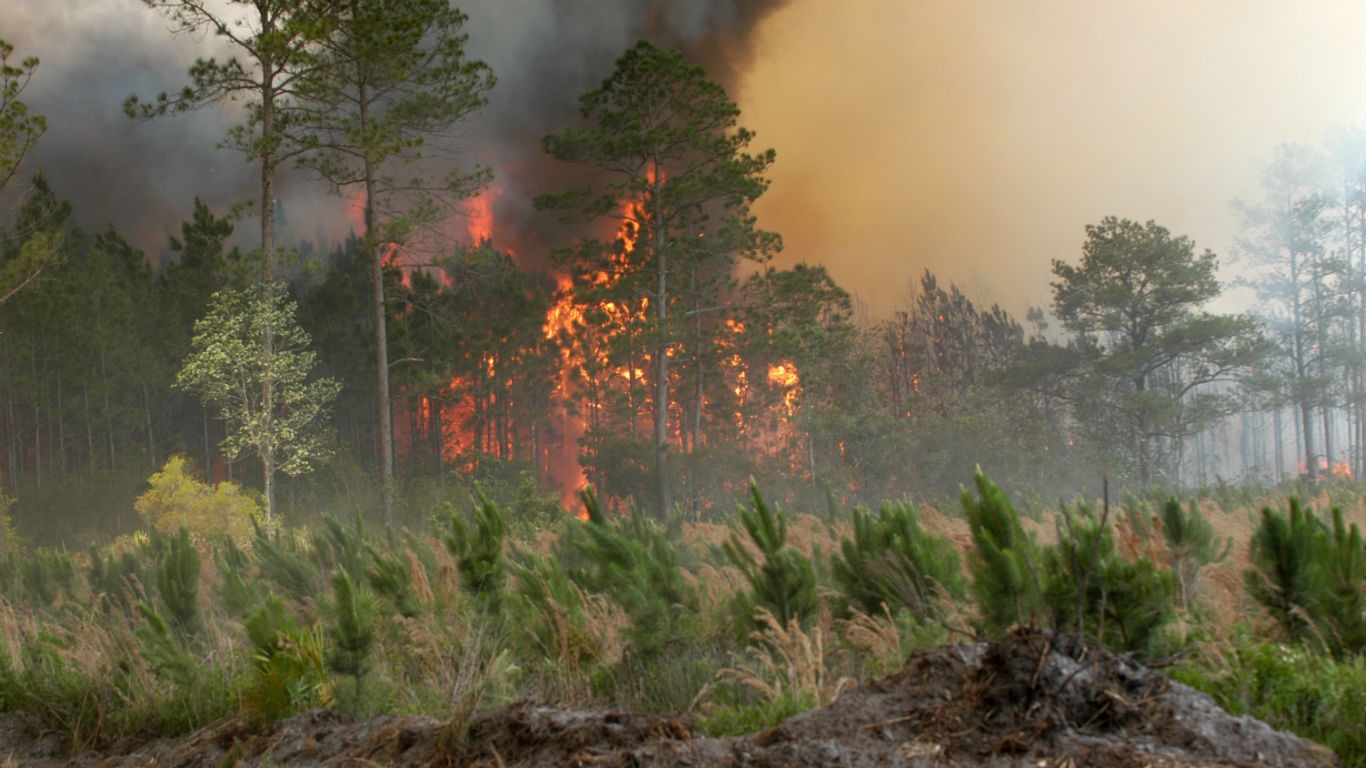
25. Big Turnaround Complex
> Area burned: 386,722 acres
> State affected: Georgia
> Year: 2007
> Cause: Downed power line
A downed tree limb was the spark that ignited the Big Turnaround Complex fire in Georgia on April 16, 2007, the biggest wildfire in the state’s history. The fire, which started at the Okefenokee National Wildlife Refuge, eventually scorched almost 387,000 acres. Since 1937, there have been more than 300 fires that have burned thousands of acres at the wildlife refuge.
[in-text-ad]
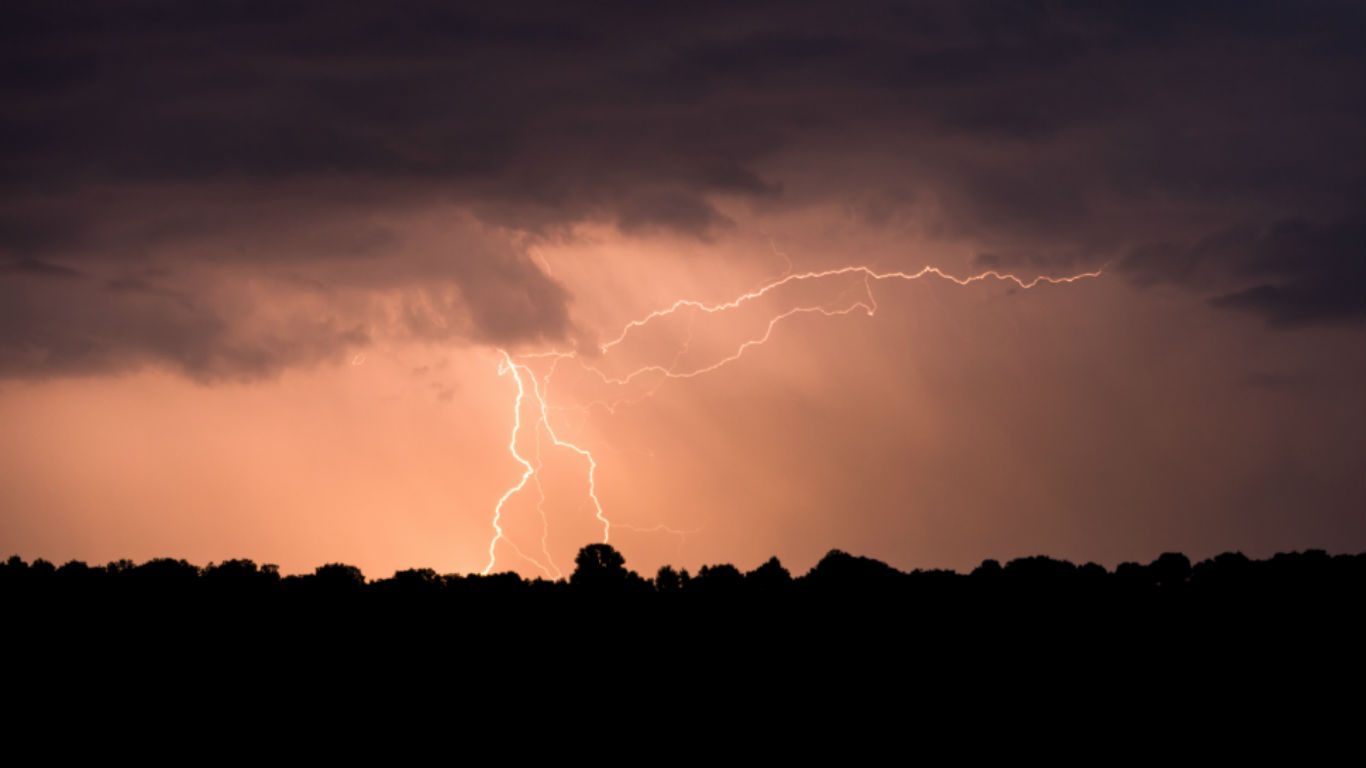
24. Buzzard Complex
> Area burned: 395,747 acres
> State affected: Oregon
> Year: 2014
> Cause: Lightning
The Buzzard Complex fire — named for the Buzzard Butte — started from a lightning strike on July 14, 2014, and wiped out almost 400,000 acres of sagebrush and bunchgrass in southeastern Oregon. The fire, which killed livestock, was the largest in the state since the Long Draw fire two years earlier.
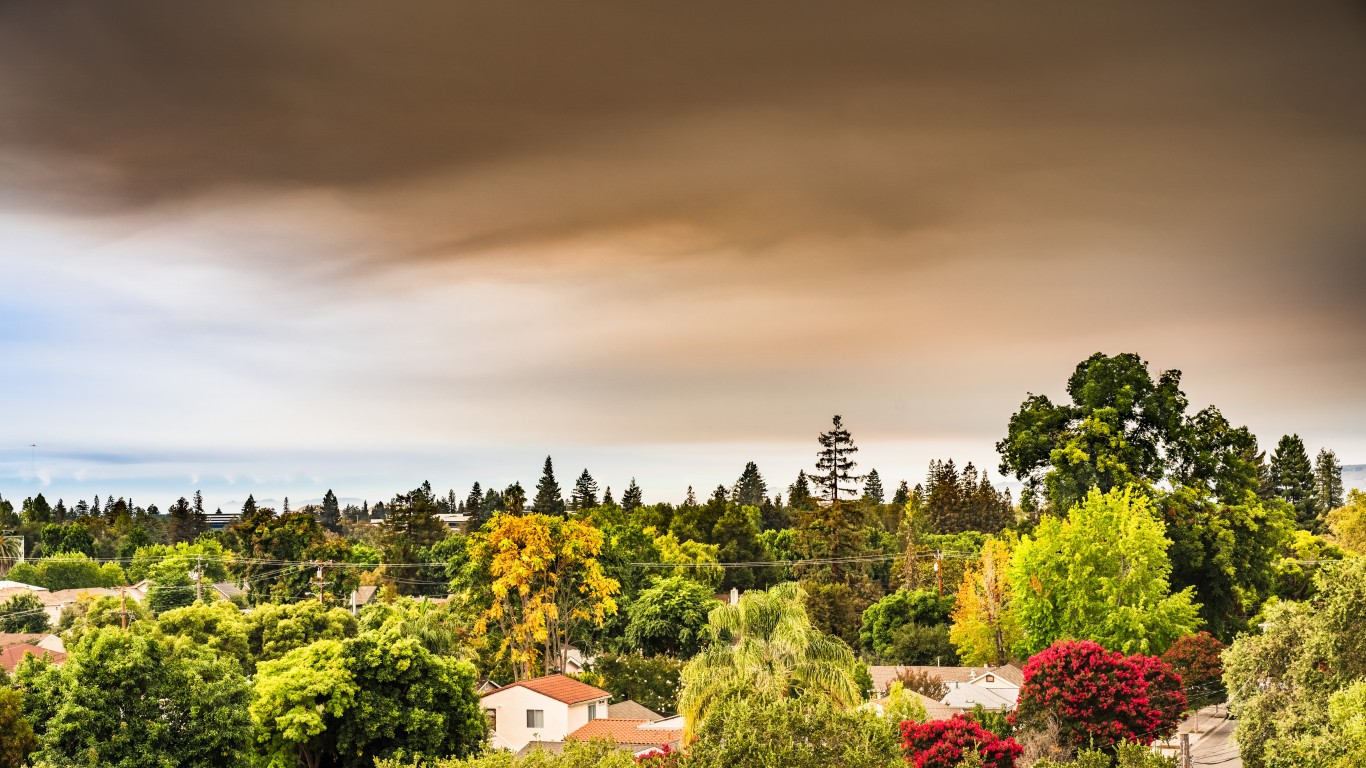
23. SCU Lightning Complex
> Area burned: 396,624 acres
> State affected: California
> Year: 2020
> Cause: Under investigation
The SCU (Santa Clara Unit) Lightning Complex burned nearly 400,000 acres across five California counties just outside of San Francisco from August to October 2020. It was fully contained after burning for 44 days. The fires destroyed more than 200 structures and injured six people. Fortunately, it did not cause any fatalities.
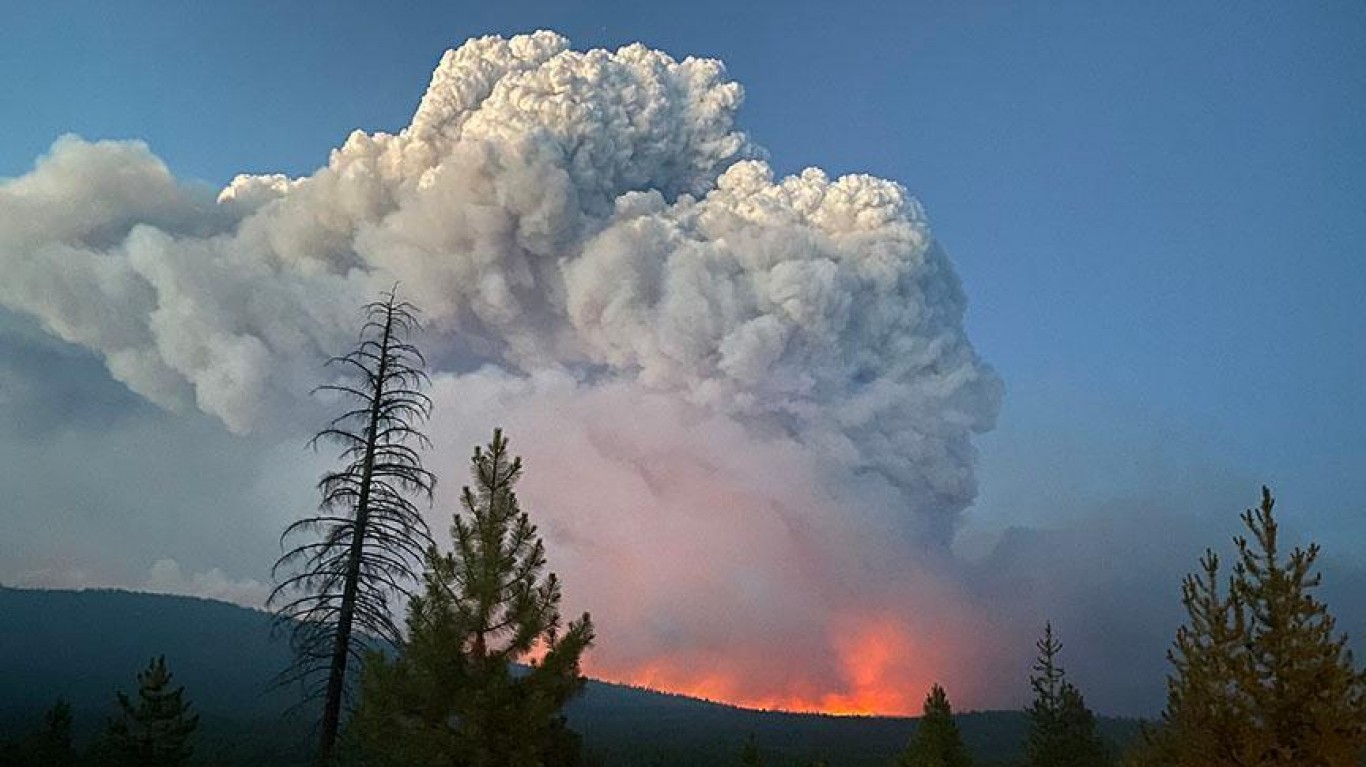
22. Bootleg Fire
> Area burned: 399,359 acres
> State affected: Oregon
> Year: 2021
> Cause: Lightning
In just 16 days throughout July 2021, the Bootleg Fire burned nearly 400,000 acres. The fire, which is yet to be contained, It is burning parts of located in Ssouthern Oregon, burning parts of the Fremon and Winema National Forests. The smoke and ash from the fire blew all the way across the continent, causing hazy skies in New York City and other parts of the West Coast. After beginning on July 6, the fire was just 38% contained as of July 22.
[in-text-ad-2]

21. Middle Yukon Fires
> Area burned: 421,613 acres
> State affected: Alaska
> Year: 2015
> Cause: Lightning
The Middle Yukon Fires, also known as the Ruby Area Fires, consisted of eight different Alaskan fires in 2015. With this fire, the 2015 fire season was the busiest in the state’s history. That year, there were tens of thousands of lightning strikes in the state throughout the summer.
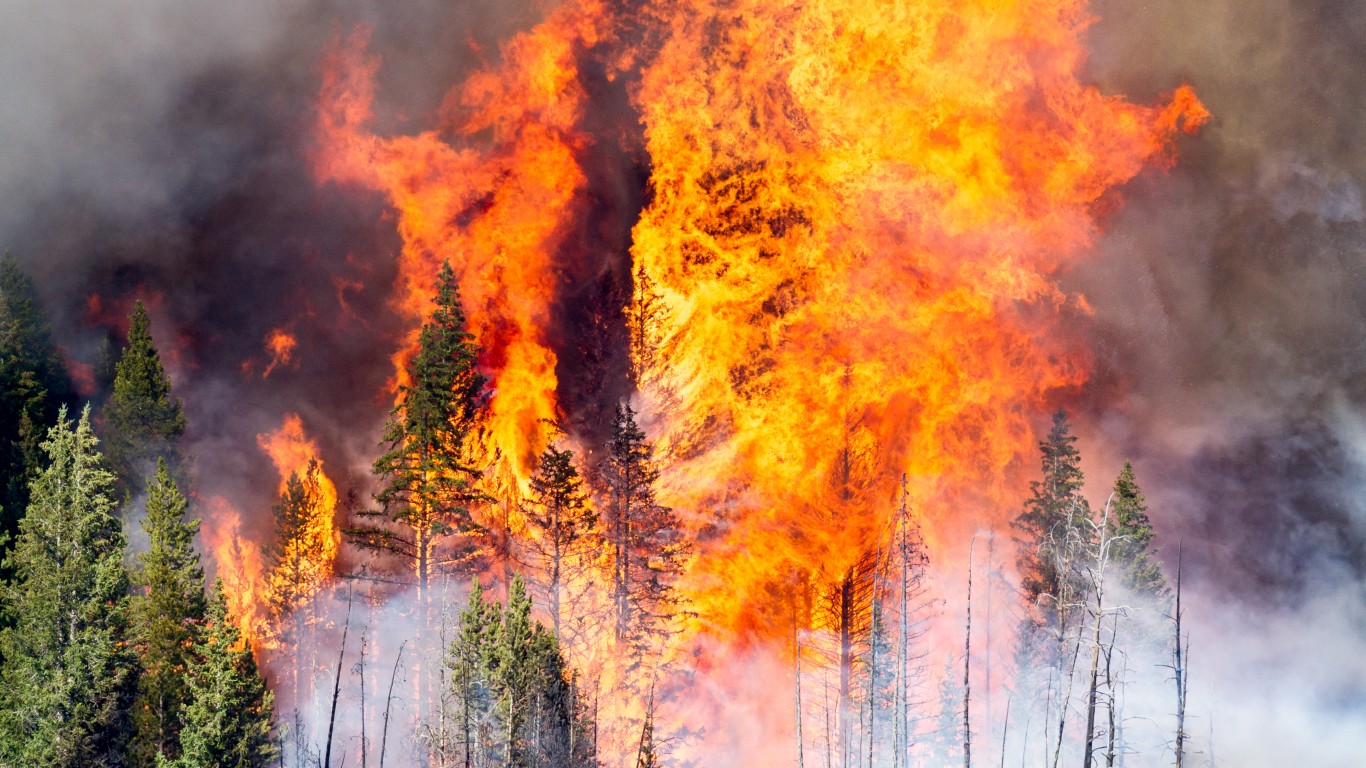
20. Martin
> Area burned: 435,569 acres
> State affected: Nevada
> Year: 2018
> Cause: Under investigation
The Martin Fire ignited on July 5 and tore through dry vegetation to become the largest blaze in the United States at that point in 2018,and the biggest single fire in Nevada’s history. It was not known how the blaze started. Hot, dry, and windy conditions, combined with vast amounts of dry grass — that had grown beyond normal levels because of heavy spring rains — accelerated the speed of the inferno, which burned more than 435,000 acres.
[in-text-ad]

19. Crazy Mountain Complex
> Area burned: 447,420 acres
> State affected: Alaska
> Year: 2009
> Cause: Unclear
The Crazy Mountain Complex of 2009 consisted of four smaller fires. Dense smoke from the infernos made it difficult for firefighters to get much needed aerial support and track the perimeter of the fire. The fire was fueled by unseasonably warm temperatures. Approximately 20 days after the complex was established, the 375 personnel assigned to the fire were able to get it under control.
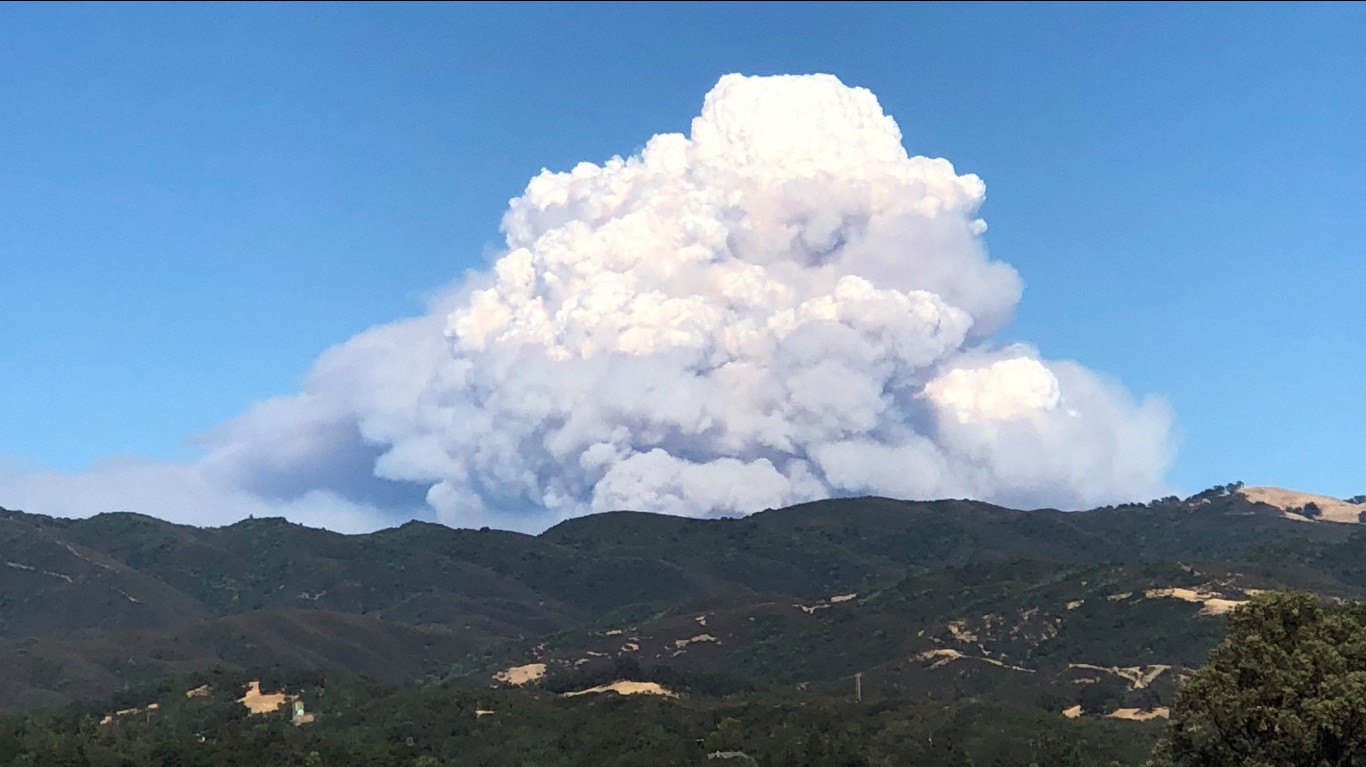
18. Mendocino Complex
> Area burned: 459,123 acres
> State affected: California
> Year: 2018
> Cause: Accident
The Mendocino Complex Fire started in late July 2018. The blaze consisted of the River Fire and the Ranch Fire. Over 100 buildings were destroyed and thousands of fire personnel worked to contain the blaze.
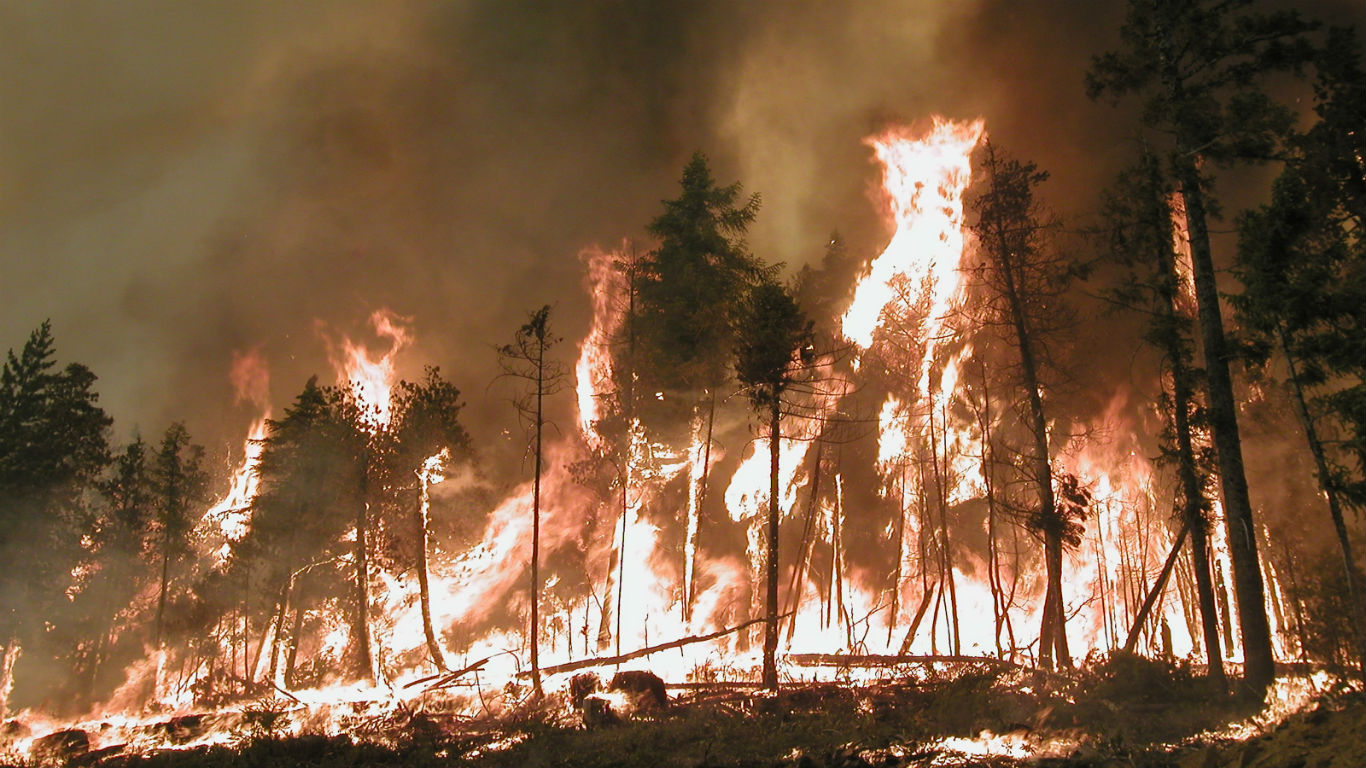
17. Holloway
> Area burned: 460,850 acres
> State affected: Nevada
> Year: 2012
> Cause: Lightning
From Aug. 5-25, 2012, the Holloway fire scorched nearly half a million acres of land in northern Nevada and southern Oregon. It was caused by a lightning strike about 25 miles east of Denio, Nevada. One firefighter was injured trying to contain the blaze.
[in-text-ad-2]
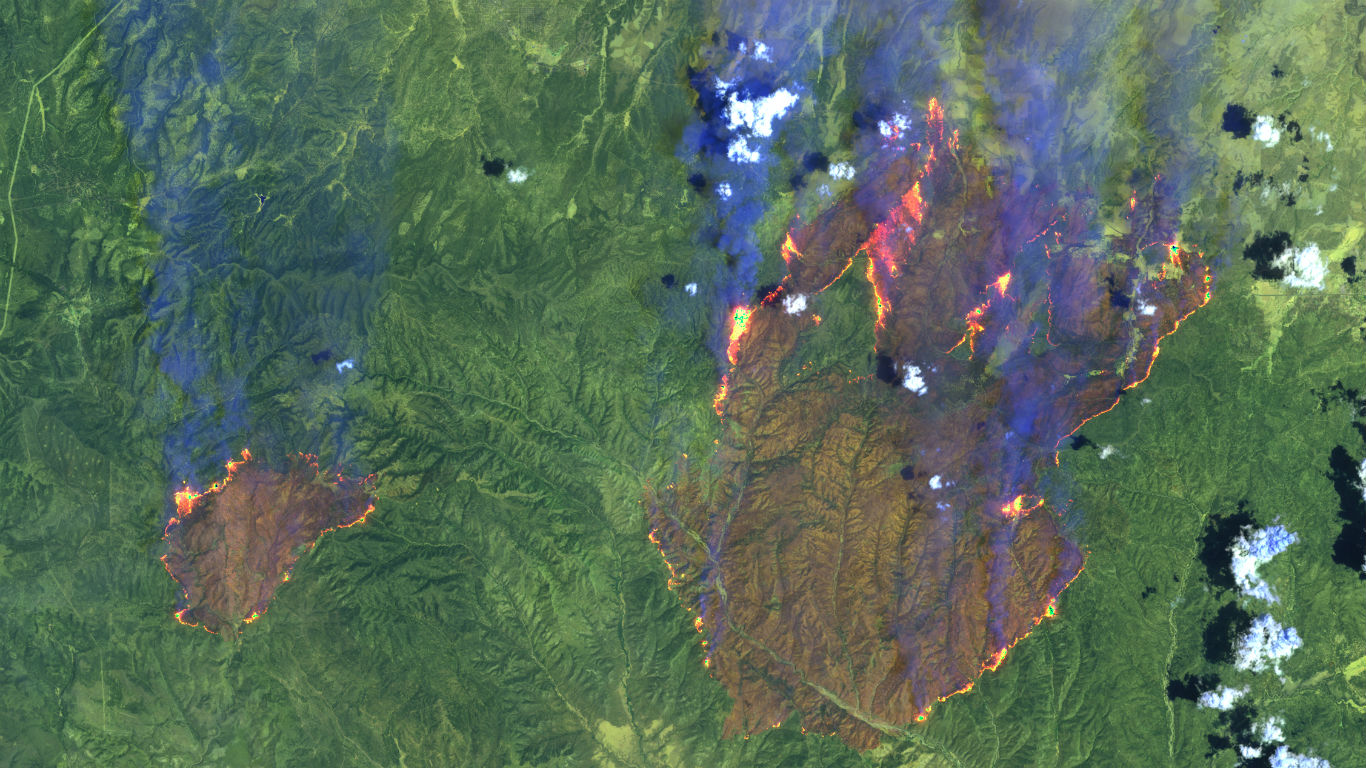
16. Rodeo/Chediski Complex
> Area burned: 468,638 acres
> State affected: Arizona
> Year: 2002
> Cause: Accident
The Rodeo Fire began on June 18, 2002, on the Fort Apache Indian Reservation near Cibecue, Arizona. Another fire ignited on Chediski Ridge, which is also on the Fort Apache Indian Reservation. The fires merged on June 22, and by the time they were contained on July 7, about 469,000 acres had been burned.
15. Tanana Area Fires
> Area burned: 498,043 acres
> State affected: Alaska
> Year: 2015
> Cause: Lightning
The Tanana Fires in central Alaska burned more than 498,000 acres, an area over half the size of Rhode Island. The blazes forced the evacuation of Tanana’s 300 residents in June. Some people had to flee by boat because the airstrip was choked with smoke, according to news reports.
[in-text-ad]
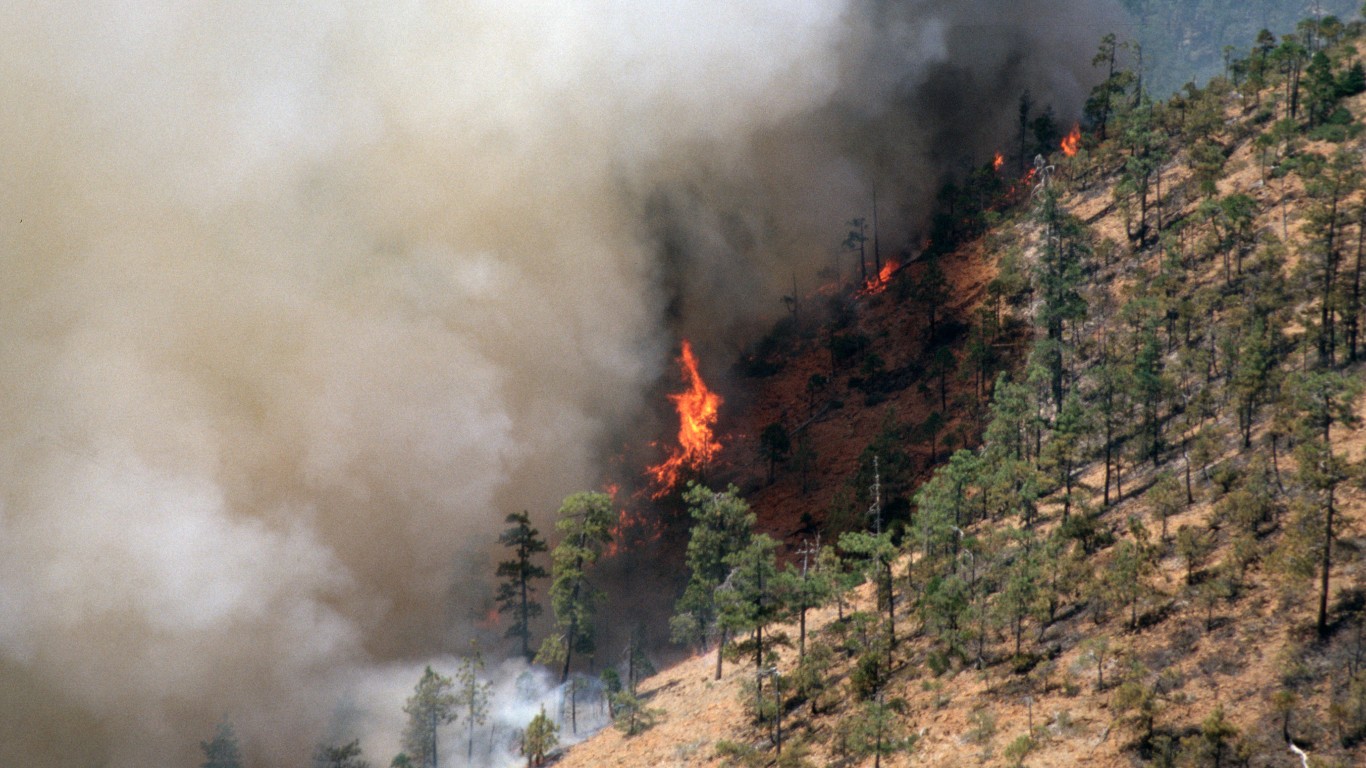
14. Biscuit
> Area burned: 500,068 acres
> State affected: Oregon
> Year: 2002
> Cause: Lightning
A lightning strike in the Kalmiopsis region in southwest Oregon ignited five fires on July 13, 2002. The blaze came to be known as the Biscuit Fire, named after Biscuit Creek in southern Oregon. It was the largest recorded forest fire in Oregon history to that point, destroying more than 500,000 acres.
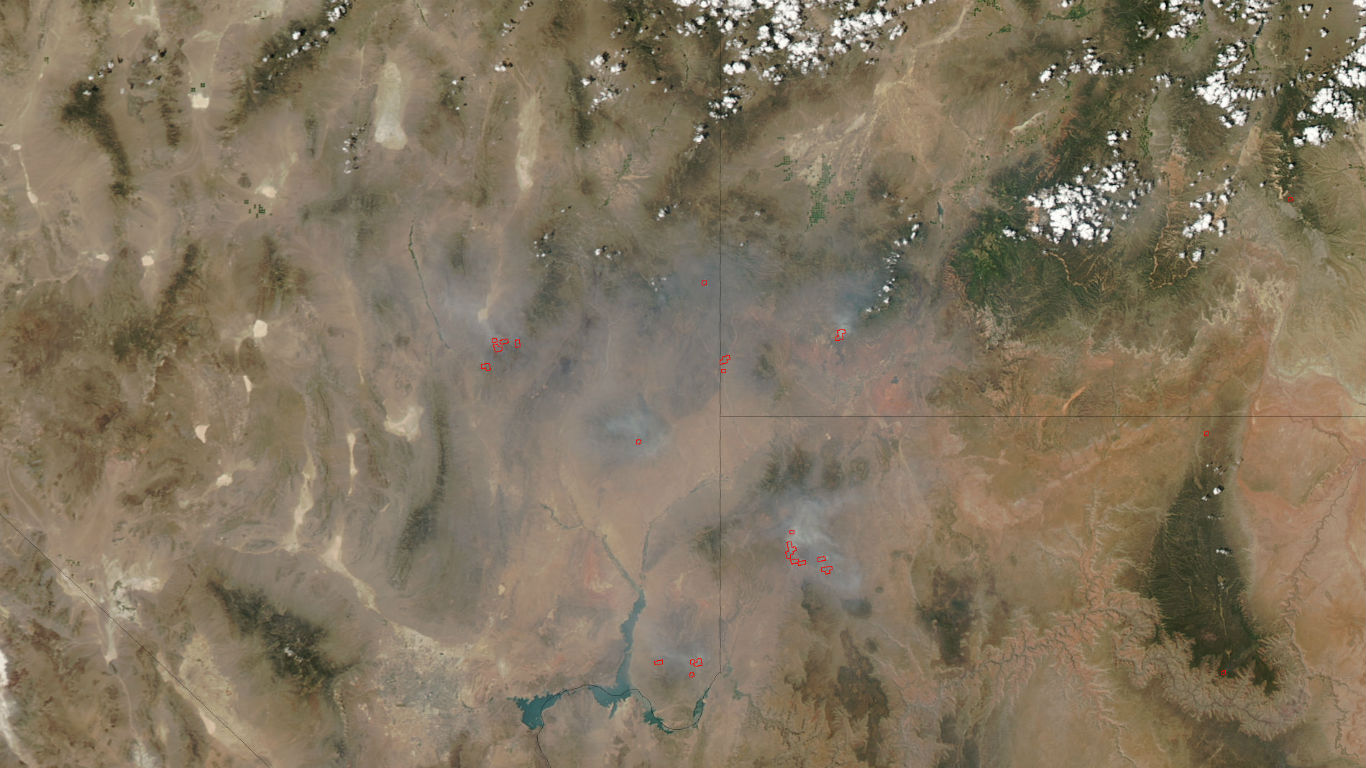
13. Southern Nevada Complex
> Area burned: 508,751 acres
> State affected: Nevada
> Year: 2005
> Cause: Lightning
The Southern Nevada Complex Fire was a devastating blaze in the Spring Mountains near Las Vegas that was started by a lightning strike in June of 2005. The fire burned more acreage, about 509,000 acres, than any other fire in Nevada. The inferno was particularly devastating to the desert tortoise population of the region. In addition to the deaths of the animal, the fire destroyed their habitat, prolonging the impact of the fire.
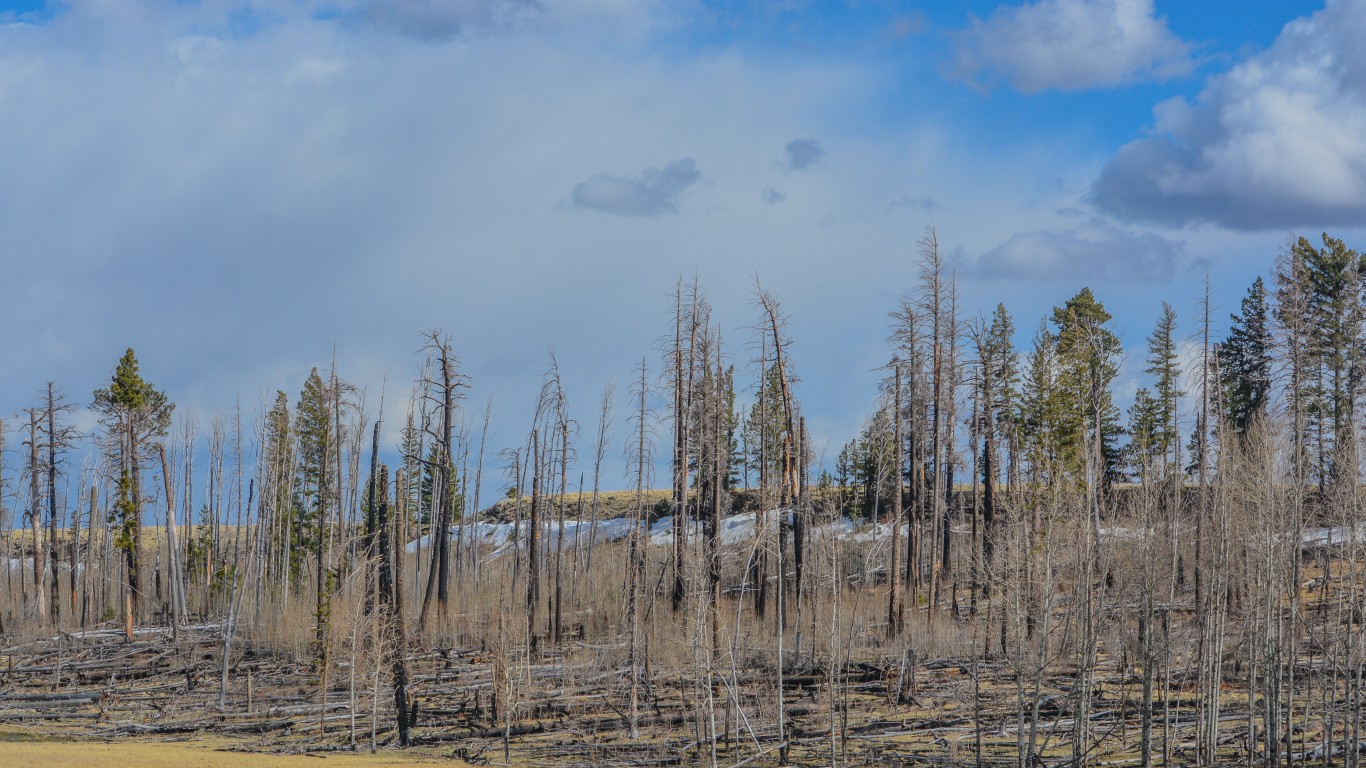
12. Wallow
> Area burned: 538,049 acres
> State affected: Arizona
> Year: 2011
> Cause: Lightning
A lightning strike on June 13, 2011, ignited the Wallow Fire, which burned in the mountains of eastern Arizona near the border with New Mexico and became Arizona’s largest fire. High winds and hot, dry weather conditions fueled the inferno, forcing the evacuation of the towns of Alpine and Nutrioso.
[in-text-ad-2]
11. Boundary
> Area burned: 538,261 acres
> State affected: Alaska
> Year: 2004
> Cause: Lightning
The Boundary Fire started on June 13 about 20 miles northeast of Fairbanks, the third most populous city in Alaska. The blaze was declared out on Nov. 30. Over 860 firefighters battled the conflagration.
10. Long Draw
> Area burned: 557,628 acres
> State affected: Oregon
> Year: 2012
> Cause: Lightning
Lightning strike was the contributing factor in the Long Draw Fire that began on July 8, 2012, southwest of Burns Junction, Oregon, in the southeastern part of the state. By the time the blaze was contained on July 16, the fire had consumed about 558,000 acres, land that had been used for foraging by livestock and as a habitat for wildlife.
[in-text-ad]
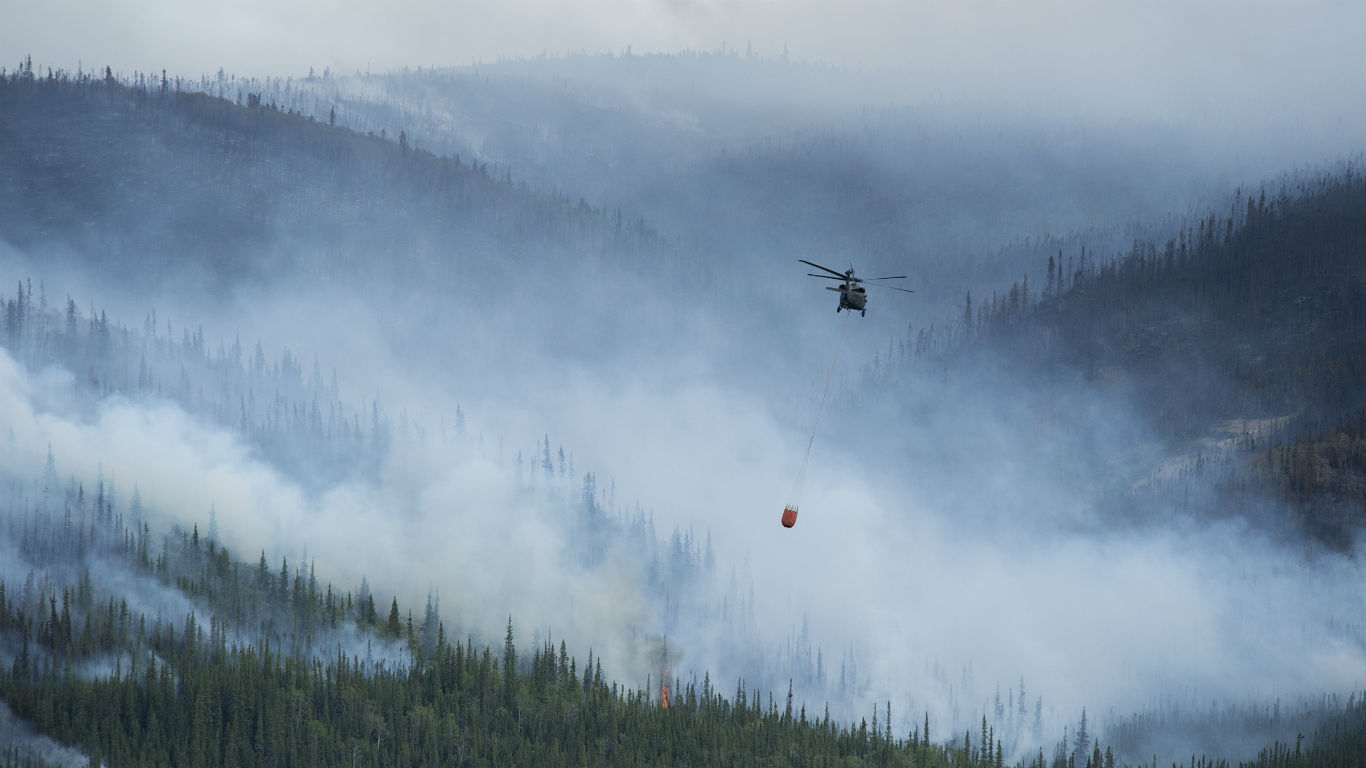
9. Central Complex
> Area burned: 574,709 acres
> State affected: Alaska
> Year: 2004
> Cause: Lightning
A spike in lightning strikes was the main cause of the Central Complex Fire in central Alaska that burned almost 575,000 acres in June and July of 2004. This fire was one of several blazes that ravaged Alaska in the summer of 2004.
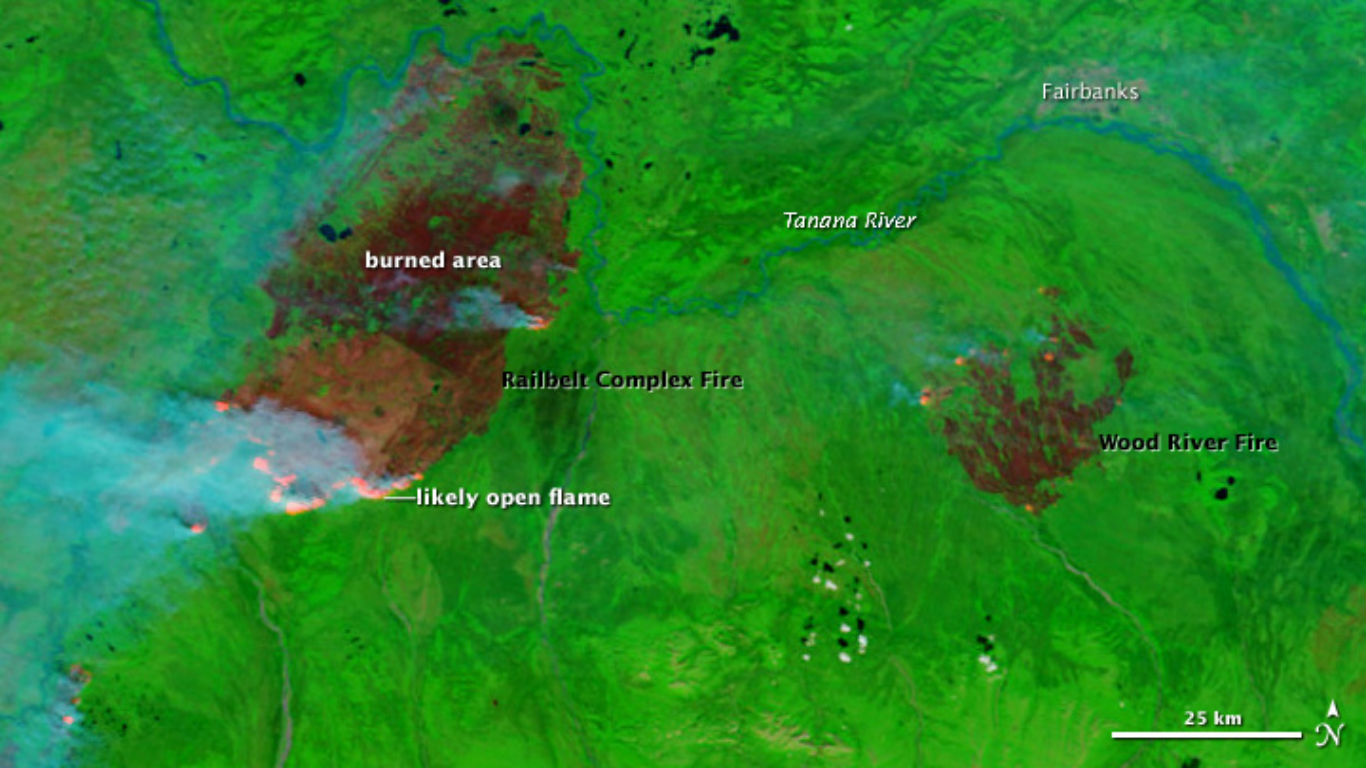
8. Railbelt Complex
> Area burned: 636,224 acres
> State affected: Alaska
> Year: 2009
> Cause: Mismanaged controlled burn
The Railbelt Complex Fire began in July 2009, when firefighters conducted a controlled burn in an area 45 miles southwest of Fairbanks. Part of the controlled fire spread on to private land, and four landowners filed a lawsuit asking for $100,000 for compensation. They also alleged “negligence and intentional misconduct” after the fire re-ignited, stoked by windy and dry weather and a lack of rainfall. In 2014, the Alaska State Supreme Court ruled that the landowners may be eligible for compensation.
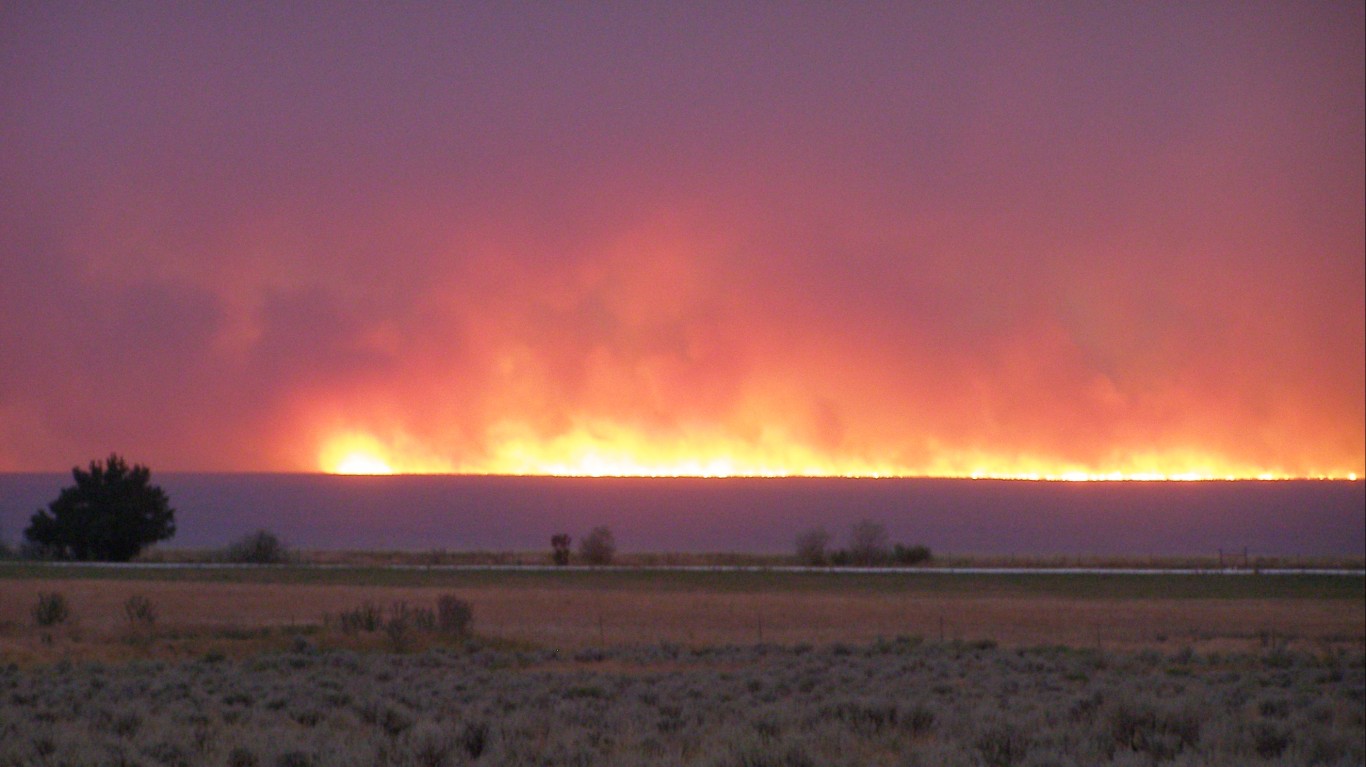
7. Murphy Complex
> Area burned: 652,016 acres
> State affected: Idaho
> Year: 2007
> Cause: lightning
The Murphy Complex Fire in July 2007 burned more than 650,000 acres in southern Idaho and was one of the worst fires in the state’s history, drawing comparisons to the notorious “Big Burn” fire of 1910 that destroyed 3 million acres in the Northwest.
[in-text-ad-2]
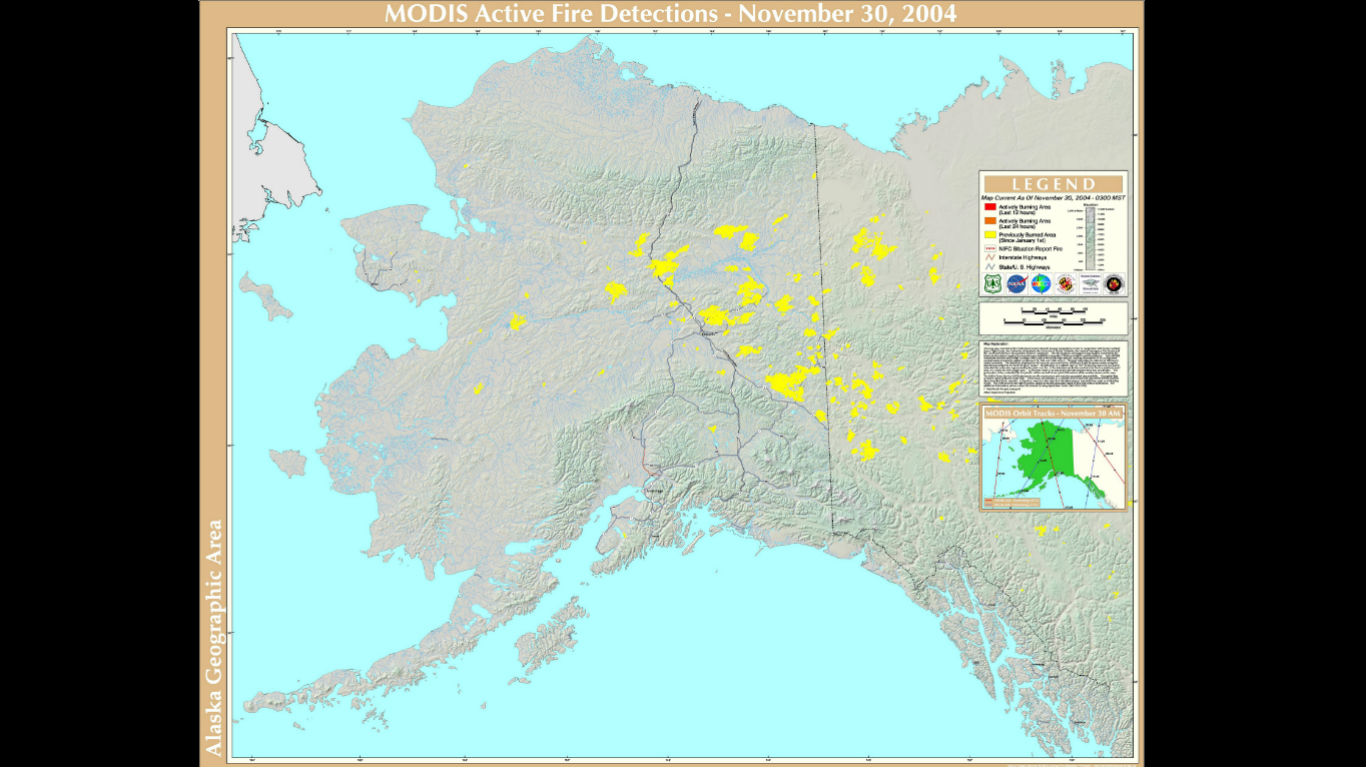
6. Eagle Complex
> Area burned: 663,305 acres
> State affected: Alaska
> Year: 2004
> Cause: Lightning
2004 was a year to forget in Alaska, as wildfires consumed much of that state’s forest and grassland. Among the worst was the Eagle Complex Fire, near the border of Canada, where more than 660,000 acres burned in the summer of 2004. The cause of the fires was lightning strikes. High gusts and dry heat were also contributing factors to the wildfires.

5. NW Oklahoma Complex
> Area burned: 779,292 acres
> State affected: Oklahoma
> Year: 2017
> Cause: Downed power line
Extreme drought, hot and dry air, a downed power line, and gusty winds combined to stoke wildfires in the Oklahoma Panhandle in March 2017. The Northwest Oklahoma Complex Fires were the largest group of fires and spanned the border between Oklahoma and Kansas. The fires had a catastrophic impact on the cattle industry, killing livestock and destroying grazing lands for animals that survived the blaze.
[in-text-ad]
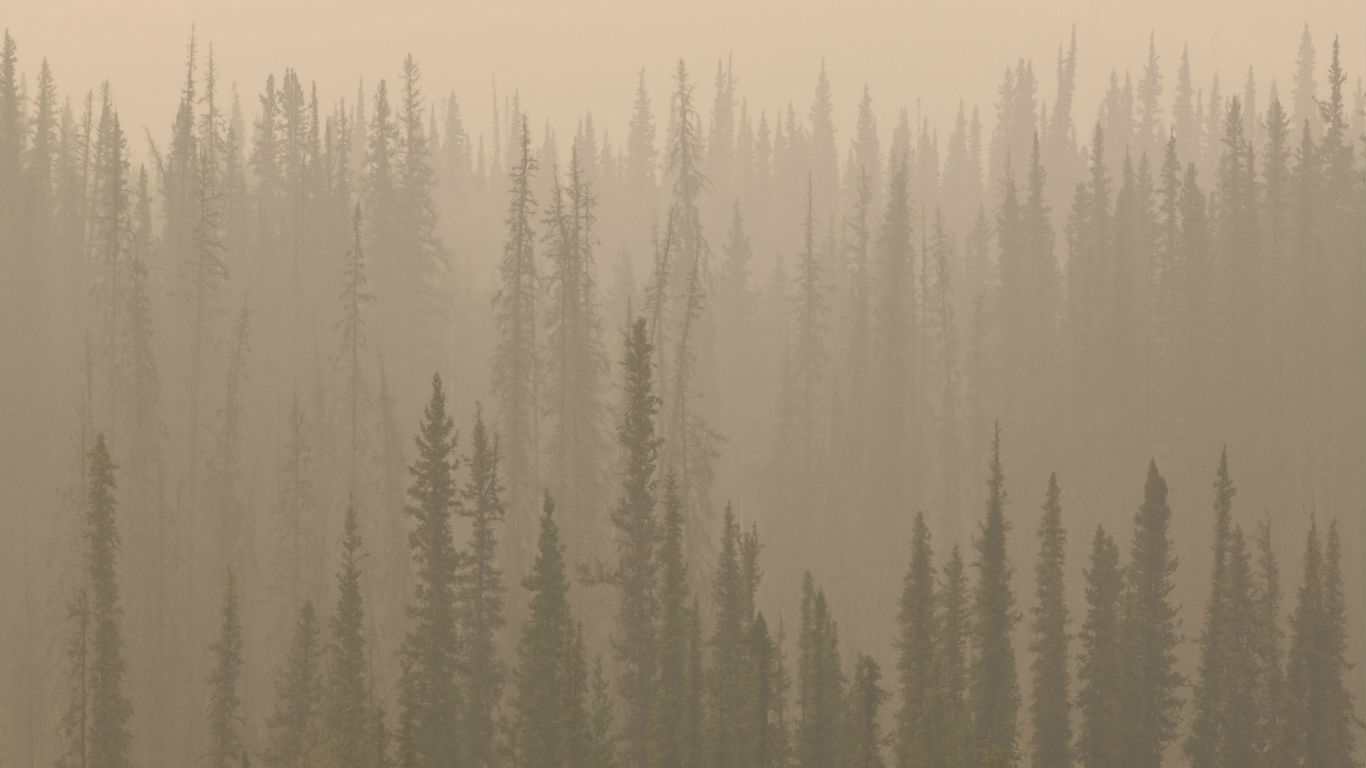
4. Solstice Complex
> Area burned: 812,771 acres
> State affected: Alaska
> Year: 2004
> Cause: Unknown
Prolonged dry weather and record heat temperatures in Alaska in mid-June were contributing factors to the Solstice Complex Fire — 19 separate fires — that burned more than 800,000 acres in the northern section of Alaska.
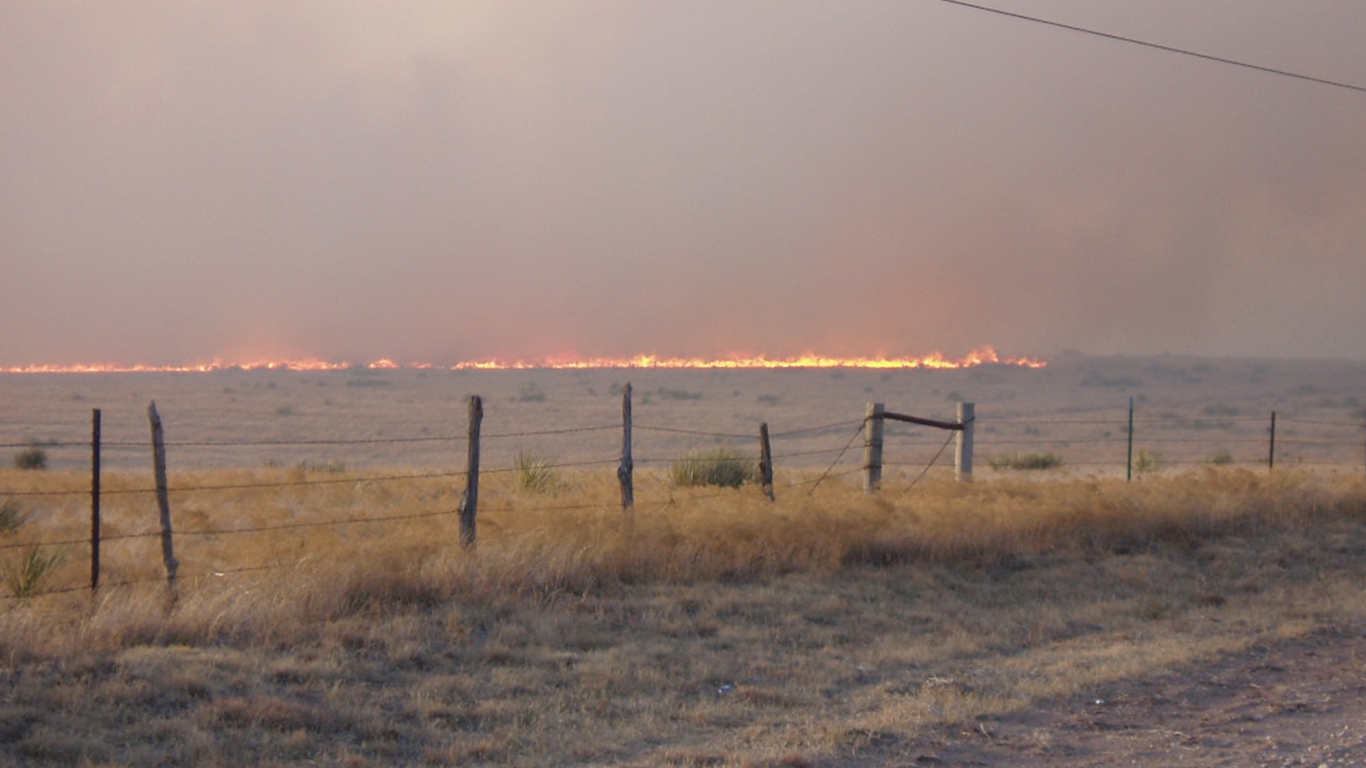
3. East Amarillo Complex
> Area burned: 907,245 acres
> State affected: Texas
> Year: 2006
> Cause: Unknown
The East Amarillo Complex fire, which broke out in the Texas Panhandle in March 2006, killed 12 people and burned almost 1 million acres. It is the largest complex fire in Texas history. The National Interagency Fire Center defines complexes as two or more fires burning in the same general area and managed as one event.
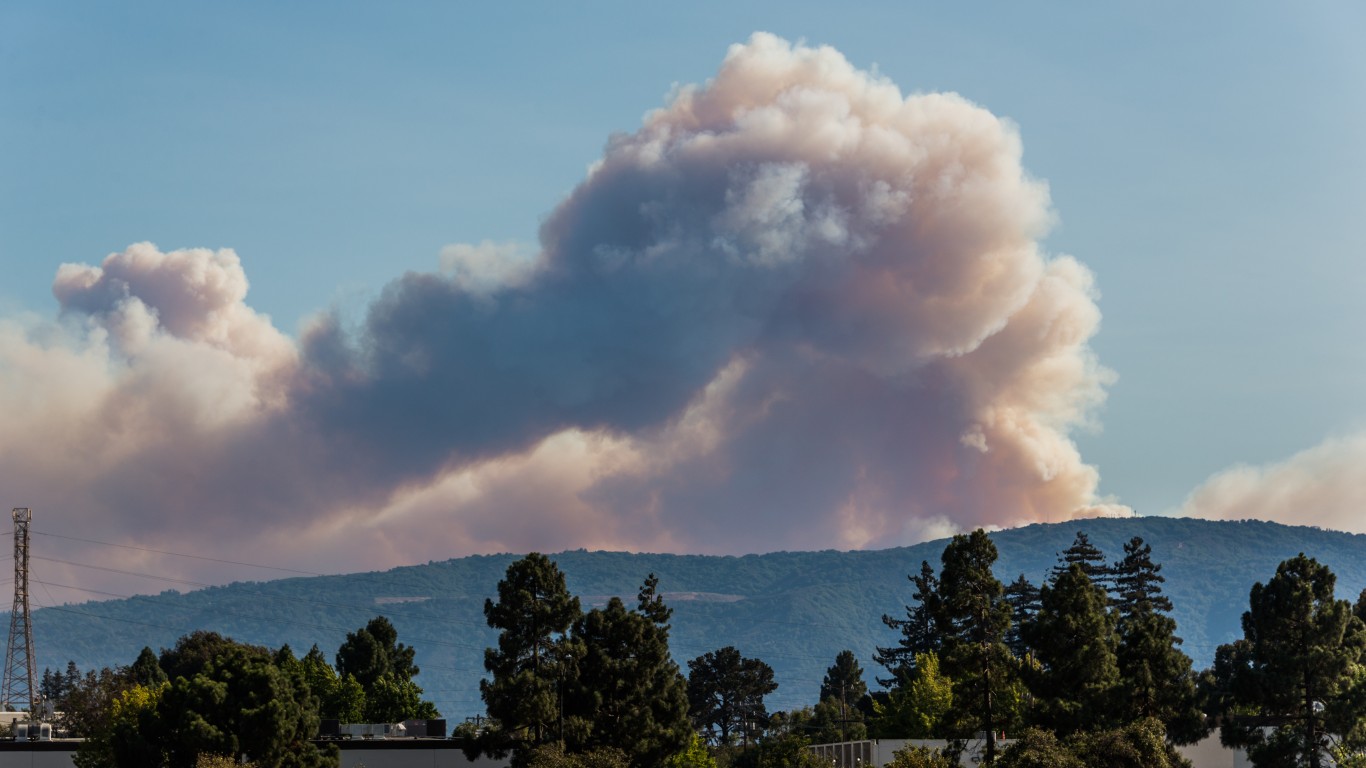
2. August Complex Fire
> Area burned: 1,032,648 acres
> State affected: California
> Year: 2020
> Cause: Lightning
The August Complex Fire in California began on Aug. 17 in the Mendocino, Shasta-Trinity, and Six Rivers National Forests. It eventually spread over seven different counties. It was described as a “gigafire” as it engulfed over 1 million acres. It is considered the largest wildfire in not just California history, but of any wildfire found in the lower 48 states. It was just the second wildfire in U.S. history to burn over 1 million acres. The fire was fueled by an extended periods of drought prior to its beginning. After nearly three months, firefighters were able to contain the blaze.
[in-text-ad-2]
1. Taylor Highway Complex
> Area burned: 1,303,358 acres
> State affected: Alaska
> Year: 2004
> Cause: Lightning
Fires erupted in Alaska in mid-June and eventually consumed more than 3.4 million acres by the end of the month. During the peak of the crisis, 466 firefighting personnel were assigned to the fire. Taylor Highway in eastern Alaska was the largest area impacted by the inferno, which raged into August, burning 1.3 million acres.
Methodology
To determine the 30 most destructive wildfires in the U.S. this century, 24/7 Wall St. reviewed data on wildfires that burned 100,000 acres or more between 2000 and 2021 from the National Interagency Fire Center’s Fire and Aviation Management Web Applications Program, as well as additional data on active and partially contained fires in 2021 from the Fire, Weather, and Avalanche Center. Data on active fires is current as of mid-day July 22.
The number of large fires, which refers to the number of fires that burned more than 100,000 acres, also came from the NIFC. Larger fires often split into several other smaller events, causing their own pattern of destruction. Fires initially part of larger incidents, as well as their aggregate fires, have been indicated.
Travel Cards Are Getting Too Good To Ignore
Credit card companies are pulling out all the stops, with the issuers are offering insane travel rewards and perks.
We’re talking huge sign-up bonuses, points on every purchase, and benefits like lounge access, travel credits, and free hotel nights. For travelers, these rewards can add up to thousands of dollars in flights, upgrades, and luxury experiences every year.
It’s like getting paid to travel — and it’s available to qualified borrowers who know where to look.
We’ve rounded up some of the best travel credit cards on the market. Click here to see the list. Don’t miss these offers — they won’t be this good forever.
Thank you for reading! Have some feedback for us?
Contact the 24/7 Wall St. editorial team.
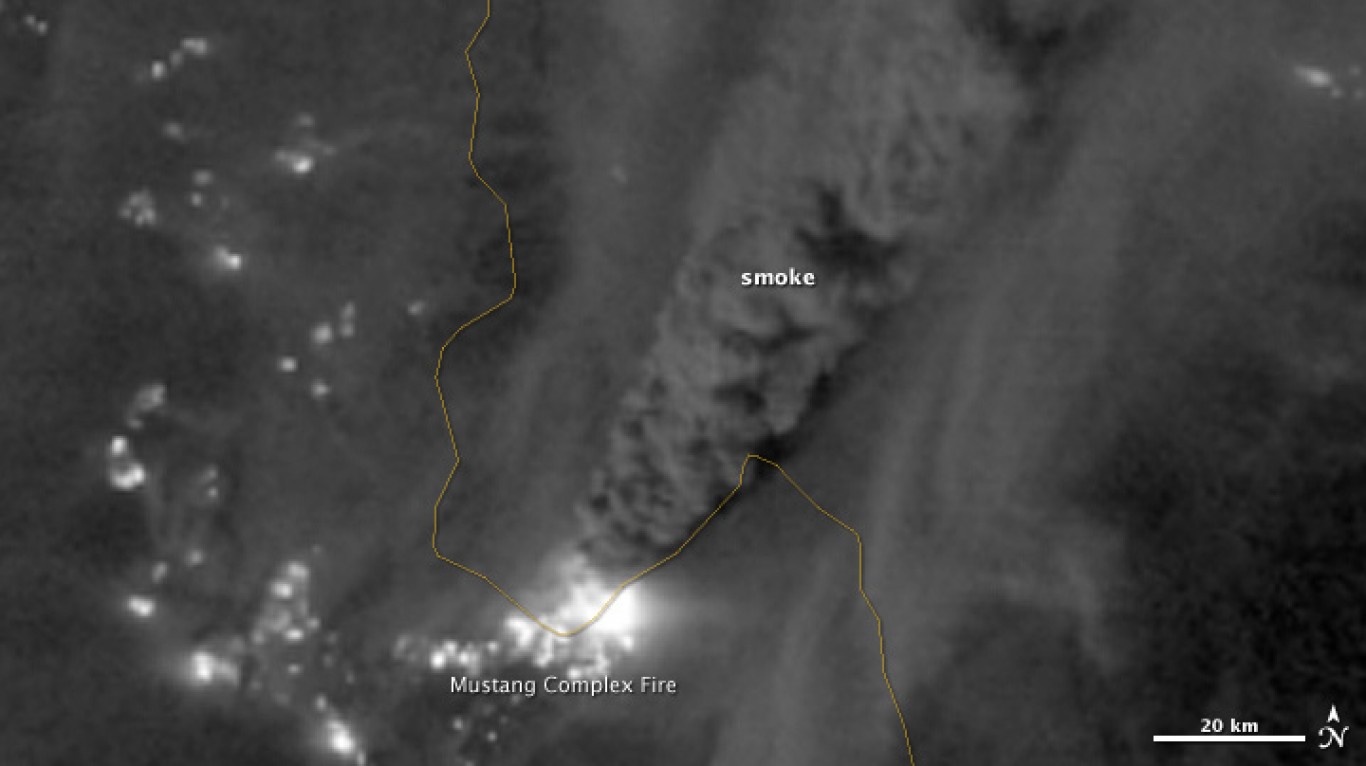

 24/7 Wall St.
24/7 Wall St.
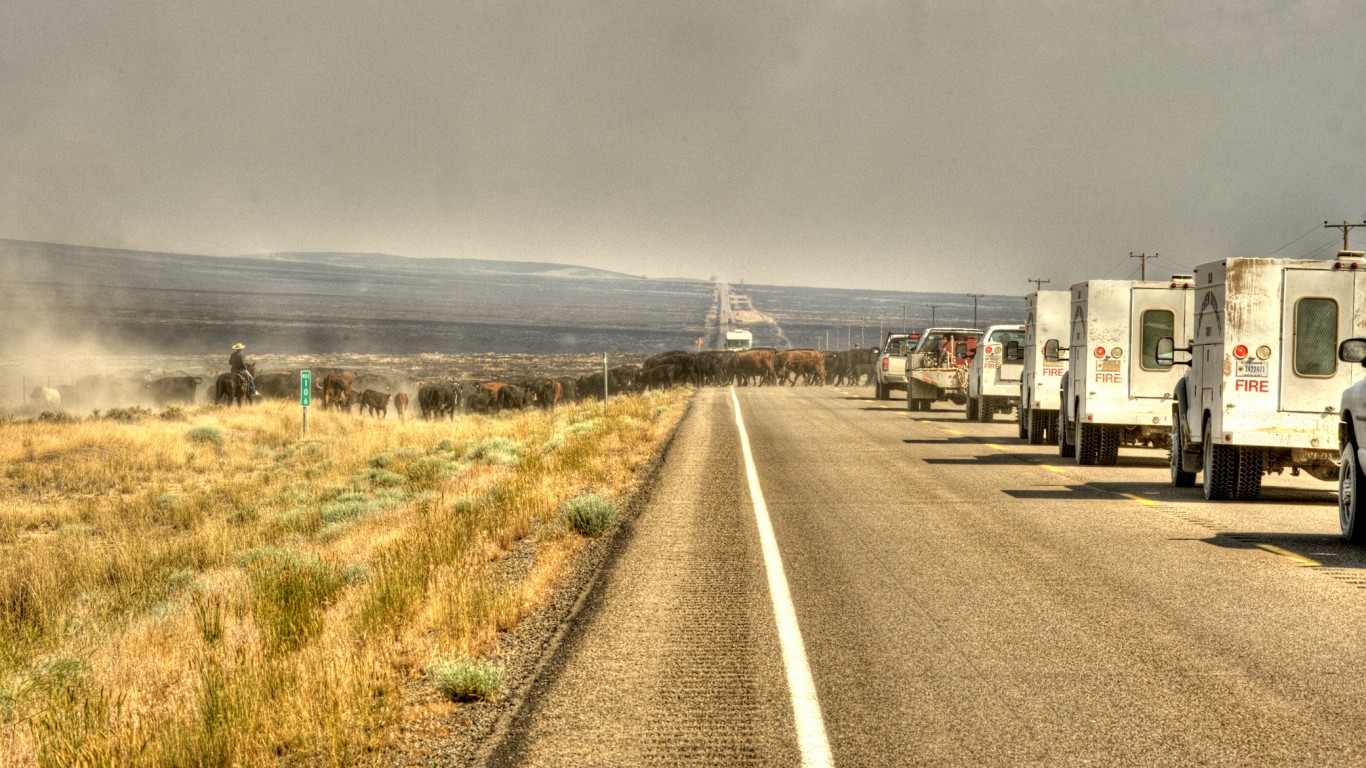
 24/7 Wall St.
24/7 Wall St.